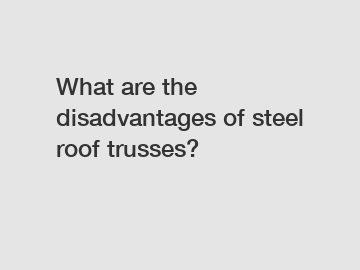What are the disadvantages of steel roof trusses?
What are the disadvantages of steel roof trusses?
Steel roof trusses have gained popularity in the construction industry for their numerous advantages. They are known for their durability, strength, and ability to withstand extreme weather conditions. However, like any other building material, steel roof trusses also have their disadvantages. In this article, we will explore some of the drawbacks of using steel roof trusses in construction projects.
1. Cost.

Steel roof trusses can be more expensive compared to other roofing materials such as wood or concrete. The cost of steel, transportation, and installation can significantly impact the overall budget of a construction project. Additionally, if the building design requires complex or customized trusses, the cost can further escalate. This can pose challenges for those operating on a tight budget.
2. Corrosion.
Although steel is a durable material, it is prone to corrosion when exposed to moisture and certain chemicals. Over time, this can weaken the structural integrity of the roof trusses. While modern steel trusses are treated to resist corrosion, proper maintenance and painting are crucial to prevent rusting. Neglecting to address this issue can lead to expensive repairs or even structural failure.
3. Fire Resistance.
Steel is not inherently fire-resistant. It loses strength and stability when exposed to high temperatures. In the event of a fire, steel roof trusses can quickly weaken, compromising the building's structural integrity and overall safety. To mitigate this risk, fire-resistant coatings or the installation of fireproof insulation can be utilized, although this adds extra cost to the construction process.
4. Thermal Conductivity.
Steel is also a good conductor of heat and cold, making it prone to thermal expansion and contraction. This can lead to issues such as leaks, noise, and energy loss. Proper insulation and ventilation systems must be put in place to minimize these concerns. Failing to address thermal conductivity can result in discomfort for occupants and increased energy consumption for heating or cooling the building.
5. Design Limitations.
Steel roof trusses offer a wide range of design possibilities, but they also have certain limitations. Compared to wood, steel is not as flexible in terms of cutting, shaping, and modification. This can restrict the creativity of architects and limit the design options for clients. Moreover, complex designs with unusual shapes or spans can increase the cost and complexity of fabrication and installation.
Despite the disadvantages, steel roof trusses remain a popular choice in the construction industry due to their many benefits. However, it is important to take these drawbacks into consideration during the planning and design phase of a project. Consulting with experienced professionals can help ensure that the advantages outweigh the disadvantages and that the project is executed successfully.
In conclusion, while steel roof trusses offer durability and strength, they also come with several disadvantages. These include higher costs, susceptibility to corrosion, fire resistance issues, thermal conductivity concerns, and design limitations. However, by employing appropriate preventative measures and adopting proper maintenance practices, these disadvantages can be mitigated to a certain extent. If you are considering using steel roof trusses for your construction project, it is recommended to consult with experts in the field to ensure the best outcome.
For further inquiries or assistance, please feel free to contact us.
If you are looking for more details, kindly visit membrane tensioned structure, Curtain wall space frame features, Glass Canopy Space Frame.
250
0
0

Comments
All Comments (0)